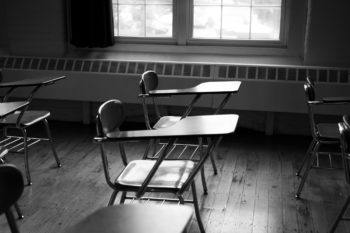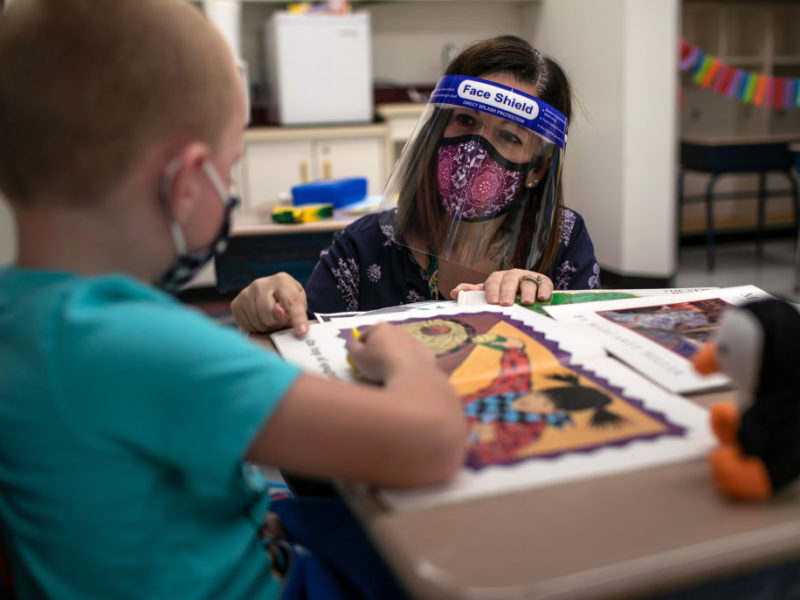Recognizing Trauma In Students As Kids Head Back To School

In addition to the normal anxiety associated with heading back to school, Texas school children may also be facing extra stressors this year.
Experts say students can be affected by trauma in several ways, such as experiencing or learning about events like the ongoing global COVID-19 pandemic and the Robb Elementary School shooting in Uvalde. Texas A&M Today spoke with two experts with backgrounds in educational psychology to better understand how trauma affects K-12 students: Jeffrey Liew and Idean Ettekal are professors in the Department of Educational Psychology in the School of Education & Human Development at Texas A&M University.
What is trauma?
Liew: Trauma is an emotional and stress response that overwhelms or interferes with a person’s ability to cope with future or further experiences of stress. Simply put, trauma can be thought of as emotional and psychological injuries. There are different types of trauma, such as acute, chronic and complex trauma depending on the frequency, duration and nature or severity of the stressful or traumatic events.
Ettekal: Trauma typically relates to significant adverse experiences and events that have an impact on children’s (and adults’) psychological, social and emotional adjustment.
Does trauma affect how students react to their environments and with other people?
Liew: Many children who experienced trauma are likely to feel unsafe or in danger, seeing people or situations in the school or classroom as potential threats. When this happens, they experience hyperarousal, which could lead them to become emotionally dysregulated and go into fight, flight or freeze reactions to perceived threats. They may also become hypervigilant, leading them to become distracted from learning and achieving academically.
Ettekal: Traumatic experiences can affect students in many ways. For some students, their reactions may involve different types of externalizing behaviors including aggression and violence. For others, the reactions may be more of an internalizing nature (like anxiety, depression and withdrawal). In both cases, these types of behaviors may impact how students get along with others.
How might trauma be expressed by students in school and in the classroom?
Liew: Trauma can be complex. Students who have been exposed to traumatic or adverse experiences show symptoms of their trauma through dysregulation of their emotions, attention or behaviors. Teachers can easily misinterpret these symptoms of trauma as misbehavior or disengagement from students. What teachers may not know is that students with complex trauma may be experiencing a hijacking of neurobiological systems so that their emotions, attention and behaviors are dysregulated or out of control. The fear and anxiety some students experience could lead to problems in learning and academic achievement, as well as social, emotional and behavioral problems, peer problems, and school absenteeism or eventual school drop-out.
Ettekal: It likely depends on how students are coping with the trauma and types of support that they are receiving. For children who are having difficulty coping with trauma, they may seem less attentive in classwork, less interested in interacting with classmates and teachers, and generally exhibiting a decline in their school engagement (for example, less participation, greater absences, decline in work quality or completion).
How does trauma affect the brain behaviorally?
Liew: Trauma can impact children’s neurophysiology and their development of self-regulation of their emotions and attention. Children who have been exposed to trauma may develop changes in their neurophysiology that impacts how they respond to everyday situations in their environment, including the school or classroom. These neurophysiological changes in children’s development could result in emotion dysregulation or an “amygdala hijack,” hypervigilance and internalizing or external problem behaviors.
Ettekal: There are likely different types of behavioral reactions associated with experiencing trauma. Perhaps the most common behavioral reactions would pertain to different types of internalizing problems, including feelings of depression, anxiety and withdrawal. Traumatic experiences may also lead to greater negative emotionality as well as greater difficulty controlling and regulating emotions, which may also lead to frustration and irritability.
How can parents, teachers and administrators provide support for students during the beginning of the school year?
Liew: Students exposed to trauma may have a difficult time trusting others, and may not feel safe around others, including teachers. Teachers’ empathy plays a critical role in being able to engage in trauma-informed teaching practices. For example, teachers who are empathetic are likely to be mindful of creating trauma-sensitive learning environments for their students. Trauma-sensitive classrooms have predictable environments and schedules, planned transitions and clear boundaries and expectations. In our own research, we found that poorly regulated or dysregulated students were able to achieve academically just as well as students with good self-regulation skills when they were paired with a positive and supportive teacher. What this tells us is that teacher-student relationships matter, especially for students who have difficulties with emotion and self-regulation.
Teachers who are empathetic know how to establish trust and bond with students. But it is also important for teachers to set clear boundaries for themselves and to practice self-care, so that they can avoid or prevent compassion fatigue and burnout.
Our students have experienced life with a global pandemic, and many of them have also known neglect, abuse, violence, natural hazards or unnatural disasters. Many of our students have shown their resilience, but many are also struggling and suffering. Parents, teachers and school leaders could go a long way to support students during the start of the school year by meeting students where they’re at because students with trauma histories can react in diverse and unexpected ways when they become triggered. Taking time to understand what may trigger students helps parents and teachers find ways to help students feel safe. In addition, while all students can benefit from predictability and consistency in the home and at school, this is particularly important for students struggling with stress or trauma. As part of this, teachers and school administrators can actively build emotionally healthy school cultures that benefit all students. For example, social-emotional learning (SEL) programs can be combined with trauma-informed approaches to promote students’ emotional self-regulation, adaptive skills and resilience, as well as a positive and safe school climate.
Ettekal: For many students, the start of the school year may already be stressful as they are transitioning to new schools or classrooms, meeting new peers and adjusting to different standards or expectations. Experiencing more significant traumatic events on top of these more typical stressors may be overwhelming for some students, and require that they seek out additional supports. First, it is important for teachers and adult staff to recognize that students may be experiencing trauma and that students may be reacting to these experiences in different ways. Second, it is essential for adults to build responsive and caring relationships with their students and to start forming trust so that their students feel comfortable approaching them and confiding in them. Third, teachers and school administrators should be aware of the school- and community-based mental health and psychological services that are available to students so that they can help students access these additional resources and supports. In our Department of Educational Psychology, we also train school and counseling psychologists and offer a variety of affordable therapeutic and assessment services to children, youth, and families through our Counseling and Assessment Clinic (CAC) at Texas A&M.
Media contact: tamunews@tamu.edu





